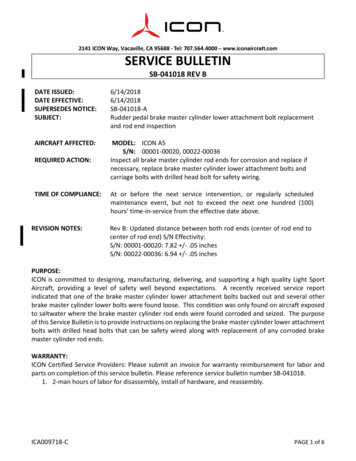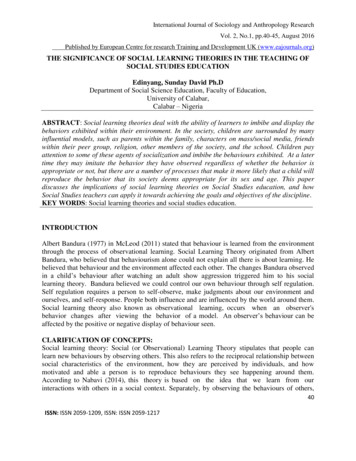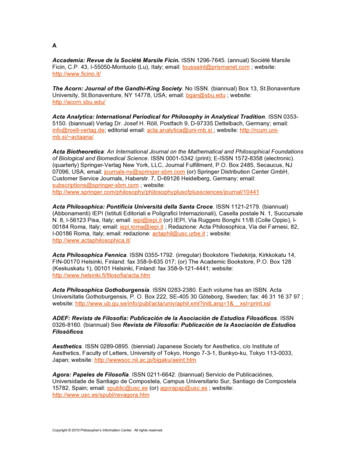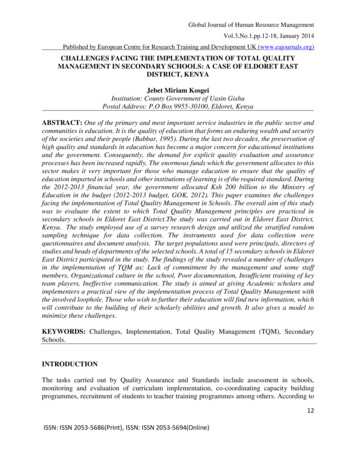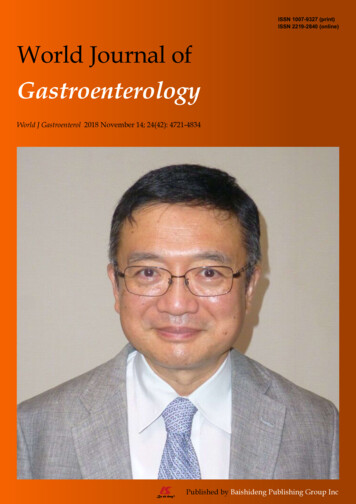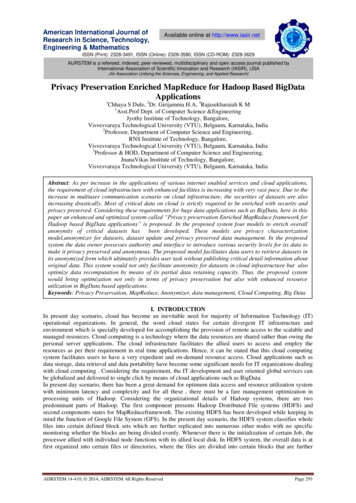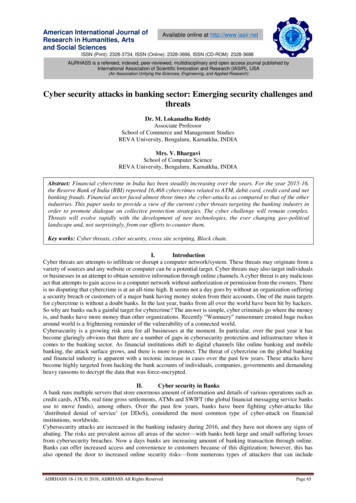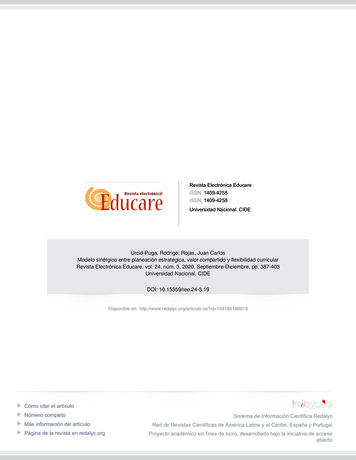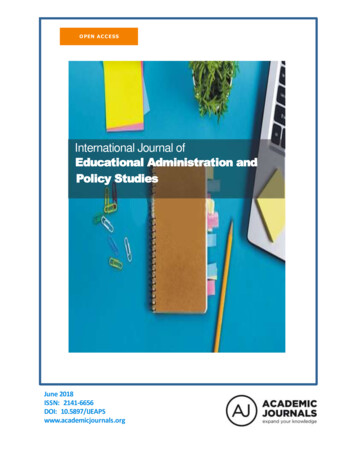
Transcription
O PE N A C C E SSInternational Journal ofEducational Administration andPolicy StudiesJune 2018ISSN: 2141-6656DOI: 10.5897/IJEAPSwww.academicjournals.org
About IJEAPSThe International Journal of Educational Administration and Policy Studies (ISSN 21416656) is published monthly (one volume per year) by Academic Journals.The International Journal of Educational Administration and Policy Studies (IJEAPS) is anopen access journal that provides rapid publication (monthly) of articles in all areas of thesubject such as Educational Governance, Policy and Administration, Educational Ethics, Lawand Special Education, Computer Applications in Educational Administration and PolicyStudies etc.The Journal welcomes the submission of manuscripts that meet the general criteria ofsignificance and scientific excellence. Papers will be published approximately one monthafter acceptance. All articles published in IJEAPS are peer-reviewed.Contact UsEditorial Office:ijeaps@academicjournals.orgHelp ww.academicjournals.org/journal/IJEAPSSubmit manuscript onlinehttp://ms.academicjournals.me/.
EditorsProf. Amalia A. IfantiDepartment of Educational Sciences and EarlyChildhood Education, University of Patras, RionPatras 26504, Greece.Dr. Suseela MalakolunthuDepartment of Educational Management andPolicy50603 Kuala Lumpur,MalaysiaProf. Ugur DemirayAnadolu University,Faculty of Communication Sciences,26470 Eskisehir,TurkeyDr. Richard J.M. SmithPolicy and Leadership Studies,National Institute of Education,Nanyang Technological University,1 Nanyang Walk, Singapore 6367616,Republic of SingaporeDr. Napoleon B.Social Development Staff (SDS),National Economic and Development Authority(NEDA,Amber Avenue,Pasig City, Metro ManilaPhilippines.Dr. H. Gülru YükselYildiz Technical University,Faculty of Education,ELT Dept., DavutpasaÐstanbul - 34210TurkeyDr. Christopher Joseph ConlanSchool of Education,Curtin University of TechnologyAustraliaDr. Terrence Edward Paupp0597 Porto CourtSan Diego, California 92124USA.Dr. Barbara LiebAdjunct Professor, College of Arts and Sciences,George Mason University,Fairfax, VirginiaUSA
Editorial BoardProf. Victor YuCavalry Education GroupSingaporeDr. Scott EacottSchool of Education,Faculty of Education and Arts,The University of Newcastle,Callaghan NSW Australia 2308AustraliaDr. Shoki O. GodwinUniversity of Ibadan,Oyo StateNigeria
International Journal of Educational Administration and Policy StudiesTable of Contents: Volume 10Number 6 June 2018cesARTICLEFactors associated with organizational commitment of academicemployees in BotswanaThabo T. Fako, Esther Nkhukhu-Orlando, Debra R. Wilson,Ntonghanwah Forcheh and James G. Linn56
Vol.10(6), pp. 56- 64, June 2018DOI: 10.5897/IJEAPS2017.0563Article Number: 6E8D73D57634ISSN: 2141-6656Copyright 2018Author(s) retain the copyright of this national Journal of EducationalAdministration and Policy StudiesFull Length Research PaperFactors associated with organizational commitment ofacademic employees in BotswanaThabo T. Fako1*, Esther Nkhukhu-Orlando1, Debra R. Wilson2, Ntonghanwah Forcheh3 andJames G. Linn41Department of Sociology, Faculty of Social Sciences, University of Botswana, Private Bag 00705,Gaborone, Botswana.2Department of Nursing, School of Nursing, Associate Professor, Austin Peay State University, 601 College St,Clarksville, TN 37044, USA.3Department of Statistics, Faculty of Social Sciences, University of Botswana, Private Bag 00705,Gaborone, Botswana.4Optimal Solutions in Healthcare and International Development, U.S.A. Professor and Institute of Sociology,University of Valparaiso, Chile.Received 17 May, 2018; Accepted 8 June, 2018Organizational commitment is a major determinant of organizational effectiveness and desirableemployee attitudes and behaviours. Highly committed academic staff are the backbone of universitiessince they play an important role in the success of their institutions. This study investigated factorsassociated with organizational commitment among academic employees of a university in Botswanausing a representative sample of 165 respondents. The study also sought to develop a parsimoniousmodel that can predict organizational commitment among academic employees in Botswana. Theresults show that about 3 out of 5 academic employees sampled showed evidence of commitment tothe university, regardless of their socio-demographic or socio-economic background. The study found11 factors that were associated with commitment to the university. Most of the factors that affectedorganizational commitment involved decisions and actions that were directly or indirectly at thedisposal and control of the management. The single most important factor that predicted commitmentto the university was acceptance of the new criteria for the assessment of academic staff, followed byperception of opportunities for research.Key words: Organizational commitment, academic employees, management, university, Botswana.INTRODUCTIONOrganizational commitment has been identified as animportant human factor which is a major determinant oforganizational effectiveness (Alsiewi and Agil, 2014),school effectiveness (Dou et al., 2017) and intrinsicmotivation which helps to stimulate university teachers toperform actions for achieving desired results (Ahluwaliaand Preet, 2017). Organizational commitment hasbecome increasingly topical in an environment of*Corresponding author. E-mail: fakott@mopipi.ub.bw.Author(s) agree that this article remain permanently open access under the terms of the Creative Commons AttributionLicense 4.0 International License
Fako et. al.resource scarcity and cutback management (Chordiya etal., 2017), which have resulted in challenges of attractingand retaining high-quality employees, and sustainingemployee morale, motivation and performance (Fako etal., 2014). It is one of the most fundamental concepts thathave been explored in relation to workforce motivationand productivity (Tolentino, 2015).The commitment of employees is at the heart ofhuman resources management (HRM) practice (Gbadamosiet al., 2007), the achievement of organizational goals(Khalili and Asmawi, 2012) and the success of manyorganizations (Yavuz, 2010). Lack of employee commitmentresults from a negative psychosomatic consequence thatcan accrue when individuals perceive poor congruencebetween themselves and their environment (Southcombeet al., 2015), which can result in turnover and attrition(Joiner and Bakalis, 2006; Meyer et al., 2002).While turnover rates can be beneficial by opening doorsfor new talent and new ideas, high turnover rates aredisruptive to an organization. High turnover rates can leadto loss of work progress, productivity, profits,organizational reputation and the attrition of therelationship built with customers (Alzubi, 2018). Highturnover rates can increase the cost of recruitment,training and retention of staff (Al-Hussami, 2008), as wellas negatively affect organizational effectiveness andsuccess, ability to achieve strategic objectives, ability tomaintain competitive advantage, and ability to maintainthe morale, productivity and quality of work of those whoremain in the organization (Alzubi, 2018).While the ability to attract, retain and developcompetent employees is important for all organizations, itis amplified for universities due to their reliance on theknowledge and skills of their academic employees(Alvesson, 2004), the complexity and ambiguity ofacademic work (Benson and Brown, 2007), the globaldemand for and shortages of quality academics, theaging academic work force and the high costs associatedwith replacing competent academic staff (Southcombe etal., 2015). Though employees are the most pricelessassets of an organization (Voon et al., 2011), academicemployees are the backbone of universities; and highturnover rates among academic employees havedetrimental effects on the development of universities (Liet al., 2017), student learning and achievement(McInerney et al., 2015) and the image of the academicsector in general (Alzubi, 2018). Since highly committedacademic staff play an important role in the success ofany tertiary institution (Ahmad et al., 2017), managers ofhigher education institutions seeking competitiveadvantage need to understand the organizationalcommitment of academic employees to their universitiesand the factors associated with such commitment.Conceptual frameworkOrganizational commitment refers to the affiliation and57involvement of an employee with his/her organization(Steers, 1977). It is a psychological state thatcharacterizes an individual‟s relationship with anorganization (Meyer and Allen, 1991). Commitment to anorganization is a positive psychosomatic consequencethat can be realised when individuals perceive goodcongruence between themselves and their organizationalenvironment (Kim 2012; Li et al., 2017), believe in theorganization‟s vision and values, desire to stay in theorganization, and want to contribute to it (Meyer andAllen, 1997).Organizational commitment of university academicemployees implies their considerable identification andinvolvement with the university (Markovits et al., 2010), abelief in and acceptance of the university‟s goals andvalues, a willingness to exert considerable effort on behalfof the university and loyalty or a strong desire to maintainmembership in the university (Mowday et al., 1979; Porterand Steers, 1982). It also implies a good personorganization fit that should result in willingness to do workthat is consistent with and promotes the reason for theexistence or purpose for which the university wasestablished.Understanding the commitment of academic employeesto the university is important in the context of thetendency for academic employees to have a strongorientation and commitment to the occupation orprofession rather than to the organization (Joo, 2010). In anyevent, the organizational and professional commitment ofacademic employees may not necessarily beincompatible. Commitment to the profession has beenpositively associated with intrinsic motivation to engage inresearch, and with greater research productivity (Beckeret al., 2017). Research productivity is consistent withacademic employees‟ desire to be well-connected andwell positioned within his/her profession (professionalcommitment). This can provide unique opportunities forsuccess that can translate to organizational access tohigh-potential employees, institutional visibility (Perry etal., 2016) and enhanced reputation that should benefit theinstitution.The commitment of employees to their work place has,historically, had three distinguishable, yet relateddimensions referred to as affective, normative andcontinuance commitment (Meyer and Allen, 1997; Meyeret al., 2002). Using Meyer and Allen‟s (1991) model, Linget al. (2002) established a five-dimensional model oforganizational commitment, which include affectivecommitment, normative commitment, ideal commitment,economic commitment and choice commitment. Affectivecommitment is an employee‟s emotional attachment to,psychological bond (Buchanan, 1974; Prinvale, 2001)with social attachment to (Still, 1983), identification with,and involvement in the organisation (Meyer and Allen,1997). It is an attitude or orientation towards anorganization which links or attaches the identity of theemployee to the organisation (Sheldon, 1971) andabsorbs the individual‟s fund of affectivity (Kanter, 1968).
58Int. J. Educ. Admin. Pol. Stud.It involves the congruence of individual values with valuesof the organisation (identification). It also involves feelingsof care for, pride in, devotion and dedication to theorganisation, as well as willingness to make sacrifices forthe good of the organisation (involvement), and tomaintain membership in the organization (loyalty)(Gbadamosi etal., 2007; Liou, 2008; Mowday et al.,1979).Normative commitment is based on a moral obligation(Meyer and Allen, 1997) to remain an employee of theorganization as a result of internalization of normativepressures (Gbadamosi et al., 2007), a sense of guiltresulting from thoughts about leaving the organisation(Fako et al., 2014), a desire to compensate favoursreceived from the organisation (Joolideh andYeshodhara, 2009), or perceived expectation toreciprocate specific benefits to an organisation (Mercurio,2015). Continuance commitment involves an instrumentalcalculation (Matthieu and Zajac, 1990) of the relativebenefits that an employee associates with staying in theorganization against the costs of leaving the ecommitment is the result of economic decisions andrationale motivated by investment of individual resourcesand anticipation of subsequent rewards (Becker, 1960). Itis a “marriage of convenience” that is driven byenlightened self-interest (Fako et al., 2014) andconsideration of what the individual would lose if they leftthe organization (Hosgorur et al., 2017). According toZhang et al. (2017) ideal commitment refers to theemployee‟s realization of their occupational ambitions;economic commitment arises from anxiety over afinancial shortfall that may result from leaving one‟s job,while choice commitment is rooted in one‟s lack ofconfidence in finding a job. Economic commitment andchoice commitment are a refinement of continuancecommitment (Zhang et al., 2017).Purpose of the studyAlthough in recent years, the concept of organizationalcommitment has been receiving much attention fromhigher education researchers (Zhang et al., 2017), mostresearch on organisational commitment has been carriedout among private sector business organisations(Lovakov, 2016). Few studies have been developed in thepublic sector, particularly in higher education institutions(Rafael et al., 2017). Research on organisationalcommitment of academic employees in the Africancontinent is rather limited (Fakoet al., 2014). This studyexplores the prevalence of organizational commitmentamong academic employees, factors that have beenreported as correlates of organizational commitment(Wang et al., 2010; Meyer and Allen, 1991; Lam and Liu,2014; Schoemmel and Jønsson, 2014) and variables thatcan be used to predict organizational commitment amongacademic employees in Botswana and use these factorsto develop a parsimonious predictive model oforganizational commitment.Understanding the commitment that academicemployees feel towards their institution is important giventhat it is linked with their performance and willingness todo more (Jing and Zhang, 2014; Plattner, 2004), studentlearning and achievement (McInerney et al., 2015), theachievement of organizational goals (Khalili and Asmawi,2012) and the institution‟s overall success (Lovakov,2016). The commitment of academic employees touniversities is important in the context of reducedgovernment funding in recent decades, increasedpressure for efficient management and self-financing ofpublic institutions, demand for academic employees toengage in work activities that go beyond teaching andresearch, to include attracting research and other funds tothe university (Rafael et al., 2017). The study should be ofpractical interest to managers of higher understanding the importance of the organizationalcommitment of academic employees to their universitiesas well as the factors associated with such commitment inan African context. The study should also advancescholarly understanding of associations and relationshipsbetween organizational commitment and independentvariables.METHODOLOGYResearch designThe study adopted a quantitative non-experimental design using asurvey instrument. The data collection instrument was a crosssectional, self-administered questionnaire. Participants wereselected from a population of academic employees with officiallyallotted office space at the University of Botswana (UB), and whosenames appeared in the University telephone directory. The studypopulation was stratified into enumeration units corresponding toacademic units with an average size of approximately nine (9)academic employees per unit. Between two (2) and three (3)academic staff were selected randomly from each enumeration unit.The questionnaire was distributed over a period of two weeks,during which follow-ups were made by research assistants to collectcompleted questionnaires. Informed consent was obtained from allrespondents. Respondents were treated anonymously, and theidentity of individual respondents was not used at any stage of theanalysis of the data. A cover letter affixed to the questionnaire,explained the nature and purpose of the study, and assuredrespondents that the information they provided would be dealt withethically. Participant observation and involvement in virtually allformal structures of the university enabled the research team toplace the study in historical context. The research protocol andinstruments were approved by the University of Botswana HumanSubjects Review Board.Measurement of organizational commitmentOrganizational commitment was measured with 18 items adoptedfrom Suliman and Lles (2000). Respondents were invited to expressthe extent of their agreement or disagreement with each statementusing a 5-point scale ranging from 1 strongly disagree to 5
Fako et. al.strongly agree. The minimum score possible was 18 and themaximum score was 90, with higher summed scores indicatinghigher levels of commitment. The wording of some questions werereversed so that a response of strongly agree indicated loworganizational commitment. Reversed items included; „I think that Icould easily become as attached to another organization as I am toUB‟, „I do not feel “emotionally attached” to UB‟ and „I do not feel astrong sense of belonging to UB‟. The measure of organizationalcommitment was found to be reasonably reliable (Cronbach‟s α 0.79).Measurement of other variablesThe questionnaire included self-report items that measuredpersonality attributes, work performance, coping with work, jobsatisfaction, stress, burnout, support at work, attachment tosupervisor, and reaction to organizational changes. Personalityattributes measured included internal locus of control, external locusof control, self-efficacy and hope. Six items adopted from Agho etal. (1992) were used to measure job satisfaction. Two of the itemswere „My job is like a hobby to me‟, „I find real enjoyment in mywork‟. Occupational stress was measured by three items thatassessed employees‟ frequency of stress, amount of stress andsickness symptoms. Burnout was assessed with six items. Supportat work was measured with 3 items while coping habits weremeasured with six items. Twelve items were used to determineattitudes to change. Examples of items included: „The WebCT willimprove the quality of teaching and learning at UB‟; „Thesemesterization policy is working well at UB‟; and „Things aregenerally getting better at UB‟. Respondents were invited to expressthe extent of their agreement or disagreement with each statementusing a 4-point scale ranging from 1 strongly disagree to 4strongly agree. The scales used to measure the different variablesdemonstrated good reliability (Cronbach‟s alpha (α) ranged between0.83 and 0.89).Measurement of background variablesIndividual background variables such as gender, age, marital status,number of dependent children, citizenship, educational level,organizational tenure and annual salary were also included. Genderwas measured by responses to a questionnaire item that askedrespondents to indicate the gender category to which theybelonged: male and female.Age categories were determined by asking respondents tochoose the age category to which they belonged from among ninecategories ranging from 29 years and younger to 65 years andolder. Marital status was determined by asking respondents tochoose a category that best described their marital status from sixchoices (single, cohabiting, married, divorced, widowed and other).Respondent‟s number of dependent children was determined byasking respondents to state the number of dependent children theyhad with categories ranging from no dependent children to 4 ormore dependent children.Respondents were also asked to indicate whether they werecitizens of Botswana or citizens of other countries. They were alsoasked to indicate the academic faculty (an academic administrativeunit with a group of related academic disciplines) in which theyworked and the number of years they had worked for the Universityof Botswana as academic staff. Level of education was determinedby asking respondents to choose a category that best describedtheir highest academic qualifications. Annual salary was measuredby asking respondents to choose from one of the five applicablesalary bands (Bands 4 to 8) that best described their annual salary.Respondents were also asked to indicate their academic rankamong the choices: professor, associate professor, senior lecturer,59lecturer and assistant lecturer.Data analysisFor the purposes of data analyses, organizational commitment wasconverted to a binary variable: 1 committed and 0 not committed.Participants who “agreed” with positively worded statements wereregarded as having organizational commitment towards theuniversity, while participants who “disagreed” were regarded as nothaving organizational commitment. All items were recoded ascategorical variables on a Likert scale.Bivariate analyses were conducted to determine the set of factorsthat were significantly associated with organizational commitmentusing Chi-squared tests of association between organizationalcommitment and independent variables. Only factors that had astatistically significant (p 0.05) associations with organizationalcommitment were discussed and later included in a hierarchicalmultiple logistic regression procedure to determine a parsimoniousmodel for predicting organizational commitment, and fordetermining the relative odds-ratios associated with each factor inline with procedures described by Aggresti (2000), Powers and Xie(2000) and Lawal (2003). The variables retained from the bivariateanalysis were imputed into the model successively using theconditional log likelihood procedure. The percentage of employeescorrectly reclassified by the fitted model was used as a measure ofgoodness of fit. Logistic regression was used to model categoricalresponse variables and predictive factors of organizationalcommitment.RESULTSA total of 165 questionnaires were fully completed andused in the study. Majority (71.5%) of the respondentswere male. Most of them (81%) were aged 40 years orolder, 72.1% were married and 63.0% were citizens ofBotswana. More than half (57.3%) were employed on apensionable basis while the rest (42.7%) were employedon a renewable fixed-term contract typically held by noncitizens and citizen-employees beyond the compulsoryretirement age of 65 years for stints of two-to-five years ata time, in line with university policy. Their academic ranksincluded: assistant lecturer (2%), lecturer (45%); seniorlecturer (34%), associate professor (9%) and professor(10%). Most of them (67.0%) had a doctoral degree.Table 1 shows the distribution of respondents byindependent factors. Majority (90.9%) had internal locusof control. A large proportion (78.2%) had a sense ofpersonal efficiency and 76.4% had a sense ofaccomplishment. Most of the respondents (84.2%) hadsome publications, 69.1% believed that the quality of theteaching and learning environment was good, and 57.6%believed that the evaluation of teaching by students wasacceptable to them.Although, most respondents (61.3%) were satisfied withtheir jobs, a large proportion (70.4%) believed that thestatus of academic staff at the university had declined inrecent years. A similarly high proportion (69.1%) did notagree with the university mission statement about theuniversity being a leading centre of academic excellencein Africa and the world, and 63% did not agree with the
60Int. J. Educ. Admin. Pol. Stud.Table 1. Distribution of respondents by independent 15.16.17.Contributing to policy makingResponding to emailsPerception of the status of academicsSatisfaction with the managementPerception of opportunities for researchPerception of the working habits of studentsSense of personal efficiencySatisfaction with the jobSense of accomplishmentAcceptance of mission statementInternal locus of controlThe quality of the managementAcceptance of evaluations by studentsSupport from administrative staffThe quality of the academic environmentPerception of the abilities of studentsDesire for a managerial jobnew assessment criteria for the appointment, promotionand review of academic staff. It is interesting to note that64.8 % of the respondents were not satisfied with theuniversity management, 60% believed that the quality ofthe university management was not good, 57% did notagree with the proposed restructuring of the academicorganisation of the university that was spearheaded bythe management team, and 55.2percent of therespondents reported that they did not contribute to policymaking at the university. In addition to being critical ofmanagement, most respondents (68.5%) did not haveaspirations for a managerial job.Organizational commitment and independent factorsThe results show that almost three (3) out of every five (5)of the academic employees sampled (59.8%) showedcommitment to the university as an organization. Severalfactors that were investigated were found to have nosignificantstatisticalassociation(p 0.05)withorganizational commitment to the university, and were notincluded in further analyses. These factors includedsocio-demographic variables such as gender, age-group,marital status, number of dependent children andcitizenship status and socio-economic variables such asincome group, rank and organizational tenure. Thefactors also included: personality dispositions such asinternal locus of control, self-efficacy and helpfulness;aspects of workload and work performance such ascourse load, student load, coping with work, work andhome conflict, sense of accomplishment, research outputperceived level of performance, perceived level ofType of response (%)Positive responseNegative ncy and sense of initiative.There were also no significant relationships betweenorganizational commitment and support from co-workers,support from supervisors and from administrative supportstaff. Personal discipline and coping strategies such aswriting down plans for the day, frequency of exercise,maintenance of a healthy diet, taking food supplements,putting in extra time, responding to e-mails were notsignificantly associated with organizational commitment.Work-related attitudes such as acceptance of theorganizational mission statement, acceptance of studentevaluation of courses and teaching, perception of thestatus of academic staff, acceptance of performancemanagement systems (PMS), attitude toward E-Learning,attitude toward semesterization (that is, course offeringswere semester-long as opposed to year-long), andperception of the quality of the teaching and learningenvironment had no significant relationship withorganizational commitment. There was also no significantassociation between organizational commitment and theamount of work-related stressor frequency of reportedstress.Factors associated with organizational commitmentThe study found a significant association (X2 4.962,df 1, p 0.026) between frequency of absenteeism tocope with work and organizational commitment. Most ofthose who were hardly ever absent (65.5%) showedcommitment to the university as compared to only 47.1%who were frequently absent from work. The study found
Fako et. al.61Table 2. Bivariate associations between organizational commitment and independent factors.S/N1.2.3.4567891011Independent variableAcceptance of the criteria for the assessment of academic staffPerception of opportunities for researchSatisfaction with the university managementPerception of the quality of the university managementAspirations for a managerial jobAcceptance of academic restructuringAdequacy of consultation by the managementWorking habits of studentsFrequency of absenteeismJob satisfactionContribution to policy makingten (10) factors that had a significant inverse association(p 0.05) with organizational commitment. These factorsincluded:(1) acceptance of the criteria for the assessmentof academic staff, (2) perception of opportunities forresearch, (3) satisfaction with the university management,(4) perception of the quality of the universitymanagement, (5) aspirations for a managerial job, (6)acceptance of academic restructuring, (7) adequacy ofconsultation by the management, (8) perception of theworking habits of students, (9) job satisfaction and (10)contribution to policy making (Table 2).Commitment to the university was shown by most ofthem that: (1) rejected the new criteria for the assessmentof academic staff (68.9%, (2) believed that the universitydid not have adequate opportunities for research andscholarship (71.1%), (3) were not satisfied with theuniversity management (67.9%); had a negativeperception of the quality of management (68.4%), (4) hadno desire for a managerial job (66.1%), (5) rejected theproposed restructuring of the academic organization ofthe university (67.7%), (6) felt that the management didnot adequately consult with employees (65.0%), (7) feltthat students had poor working habits (67.8%), (8) did notreport signs of burnout (67.9%), (9) were not satisfiedwith their jobs (69.8%), and (10) had not contributed topolicy making (61.2%).Predictive model for organizational commitment tothe uni
Yildiz Technical University, Faculty of Education, ELT Dept., Davutpasa- -34210 Turkey Dr. Christopher Joseph Conlan School of Education, . Austin Peay State University, 601 College St, Clarksville, TN 37044, USA. 3Department of Statistics, Faculty of Social Sciences, University of Botswana, Private Bag 00705, Gaborone, Botswana.
